Source: Greenpeace International
By Jon Burgwald - May 22, 2012
It’s late in the evening, but the sun has not yet settled here in Usinsk in the northernmost part of Russia where my Russian colleague and I arrived in a storming blizzard a few days ago.
Located just at the border of the Arctic, Usinsk is the oil capital of Russia’s Komi Republic and even though the city has a meagre size, the oil industry’s influence is unfortunately far from meagre.
Usinsk is located close to a basin of rivers, which were once full of life. But this was before oil was discovered back in the 1970s and today the picture is completely different. The area has turned into a dystopia, where smoke from burning oil and gas flares paint the horizon.
Flaring — besides emitting massive amounts of CO2 to the atmosphere — is releasing a wide range of toxins into the environment and is known to cause cancer. The Russian government promised back in 2007 that it would stop the use of gas flaring (at the time Russia was responsible for more than 25 percent of all flaring in the world).
Apparently this is not the case in Komi. The threshold for when flaring poses a health risk is several thousand times less than the threshold from which the chemicals from the burning can be smelled. Today I drove for more than half an hour through an area where we could barely breathe due to the distinct, foul smell from the flaring. I can still taste it even now.
But flaring is far from the only problem. Today, there is no control of the oil industry and its safety measures. The oil pipelines are left to corrode and the never-ending repairs are happening at an excruciatingly slow pace. This means oil spills are a weekly, it not daily event.
We also visited Kolva, one of the local villages in the area. Here the locals told us about their everyday life and how it has been affected by the oil industry. They named the village after the river, which the village is located next to. The Kolva River used to be the villagers’ source for fresh water and food. They used to be able to drink the water directly from the river and the fish used to be plentiful. Today the river is more known for transporting ice painted black by the oil. In fact, oil slicks cover almost the entire surface.
The days when the locals could drink the water are long gone and there are hardly any fish left. But when asked about the worst consequences of the pollution, the villagers don’t even mention their own situation. No, the worst consequences were for the villages further downstream. As they don’t have any wells, they don’t have any other choice than to drink the water from the river. As a result, the cancer rates in those villages have gone through the roof.
While in Usinsk, I also did some research on the official numbers of spills and the findings revealed why the situation is so grim. While there are no isolated figures for the Komi region, the Russian Minister for Nature estimated in April that about 300-500 million litres of oil are leaked into the Arctic through Russia’s rivers every year.
Let’s put that in context.
We all remember the Gulf of Mexico catastrophe, when the BP-operated Deepwater Horizon rig exploded, killing 11 people and causing a staggering 780 million liters of oil to leak unchecked into the Gulf of Mexico. The spill was America’s worst environmental disaster and caused long-term damage to the delicate ecology of the Gulf region. The terrible photographs and videos of oiled seabirds and turtles illustrated the true cost of extreme oil.
But in Russia each year up to 500 million liters of oil leaks into the river systems that feed the Arctic Ocean. In other words, although the BP oil spill was an isolated incident, the same amount of oil that wrecked the Gulf coast spews from Russian oil fields into the freezing waters of the Arctic Ocean every 18 months.
But unless you live in this region, or have visited it yourself, it’s unlikely that you’d ever know such incredible environmental destruction was happening so regularly.
This is the hidden story of Russia’s Arctic nightmare.
As a Greenpeace campaigner, I’m used to confronting and being confronted with the challenges and problems our world is facing. Over time I might even have toughened up a bit, so the almost daily doses of destruction and ongoing indifference to the world we live in didn’t break my back or my spirit.
But this is one of the times, where I have to admit that I’m not able to keep a personal distance. Even as I write this, I feel guilty as my words sound hollow compared to what we are seeing here. I honestly don’t know if it is too late to save this once beautiful area, but I know that if we don’t act now — here and in the rest of the Arctic — what I’m witnessing will only be the tip of the iceberg.
Jon Burgwald is a Greenpeace Nordic Arctic campaigner
miércoles, 30 de mayo de 2012
RUSSIA: OIL DISASTER IN THE ARCTIC
domingo, 27 de mayo de 2012
OF LIONS AND MEN
viernes, 25 de mayo de 2012
CHRIS JORDAN: PLASTIC POLLUTION ON MIDWAY ISLAND
“The sun, the moon and the stars would have disappeared long ago... had they happened to be within the reach of predatory human hands.”
Havelock Ellis, The Dance of Life, 1923
Read more...
Quotation source: Welcome to The Quote Garden
lunes, 21 de mayo de 2012
CHICKENS´ HELL: HUMANS MUST LEARN TO LOVE THEIR BRETHREN ON EARTH
THE EGG INDUSTRY
IS CRUEL! BE COMPASSIONATE! DON´T SUPPORT THE EGG INDUSTRY WITH YOUR MONEY.
DON´T EAT EGGS!
Source: all-creatures.org
Hatchlings
 (Chicken - Baby - 01) At the hatchery, chicks enter this world inside drawers of huge incubators They have no mother to take care for them as God intended. Every time we see a scene like this one we think of Jesus' words as He looked upon Jerusalem: "...how often I have longed to gather your children together, as a hen gathers her chicks under her wings, but you were not willing" (Matthew 23:37). And now, because of the hardness of heart of human beings, the analogy of a hen gathering her chicks under her wings is no longer applicable. (Chicken - Baby - 01) At the hatchery, chicks enter this world inside drawers of huge incubators They have no mother to take care for them as God intended. Every time we see a scene like this one we think of Jesus' words as He looked upon Jerusalem: "...how often I have longed to gather your children together, as a hen gathers her chicks under her wings, but you were not willing" (Matthew 23:37). And now, because of the hardness of heart of human beings, the analogy of a hen gathering her chicks under her wings is no longer applicable. |
 (Chicken - Baby - 02) The lives of male chicks have no value to an egg farmer. In this photo, unwanted male chicks struggle to survive amid egg shells and garbage in a dumpster behind a hatchery for laying hens. They were just thrown out with the trash. (Chicken - Baby - 02) The lives of male chicks have no value to an egg farmer. In this photo, unwanted male chicks struggle to survive amid egg shells and garbage in a dumpster behind a hatchery for laying hens. They were just thrown out with the trash. |
 (Chicken - Baby - 03) These are more male chicks that have been thrown away as garbage at a hatchery for laying hens. Some people mistakenly think that there is no death involved in the egg business, but they are sadly mistaken. To begin with, for every laying hen there is a dead male chick. At some hatcheries, if the males are not thrown away, they are ground up alive, mixed with grain and fed to the females. (Chicken - Baby - 03) These are more male chicks that have been thrown away as garbage at a hatchery for laying hens. Some people mistakenly think that there is no death involved in the egg business, but they are sadly mistaken. To begin with, for every laying hen there is a dead male chick. At some hatcheries, if the males are not thrown away, they are ground up alive, mixed with grain and fed to the females. |
 (Chicken - Baby - 04) This photo, and the next nine photos of dead baby male chickens are from Germany, where about 40,000,000 male chicks are thrown away in trash containers to suffocate to death every year, simply because they have no commercial value in the egg industry. (Chicken - Baby - 04) This photo, and the next nine photos of dead baby male chickens are from Germany, where about 40,000,000 male chicks are thrown away in trash containers to suffocate to death every year, simply because they have no commercial value in the egg industry. |
 (Chicken - Baby - 05) These dead baby male chicks never got to enjoy life as God intended. No wonder God said, "The intent of man's heart is evil from his youth" (Genesis 8:21). (Chicken - Baby - 05) These dead baby male chicks never got to enjoy life as God intended. No wonder God said, "The intent of man's heart is evil from his youth" (Genesis 8:21). |
 (Chicken - Baby - 06) This is a closer look at some of the 40,000,000 male chicks that are killed by the egg industry in Germany every year. This number is estimated to be about 4 times larger in the United States. (Chicken - Baby - 06) This is a closer look at some of the 40,000,000 male chicks that are killed by the egg industry in Germany every year. This number is estimated to be about 4 times larger in the United States. |
 (Chicken - Baby - 07) More murdered male chicks...their lives are considered worthless by the egg industry, so they are thrown away as trash. (Chicken - Baby - 07) More murdered male chicks...their lives are considered worthless by the egg industry, so they are thrown away as trash. |
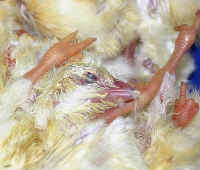 (Chicken - Baby - 08) He and his brothers never got to know life as God intended. Human greed cut their lives short. (Chicken - Baby - 08) He and his brothers never got to know life as God intended. Human greed cut their lives short. |
 (Chicken - Baby - 09) These dead male chicks prove that there is nothing humane about egg farming. (Chicken - Baby - 09) These dead male chicks prove that there is nothing humane about egg farming. |
 (Chicken - Baby - 10) Just so much trash... (Chicken - Baby - 10) Just so much trash... |
 (Chicken - Baby - 11) And more trash... (Chicken - Baby - 11) And more trash... |
 (Chicken - Baby - 12) Every person who eats eggs contributes to the death of these baby male chickens and their mothers. (Chicken - Baby - 12) Every person who eats eggs contributes to the death of these baby male chickens and their mothers. |
 (Chicken - Baby - 13) The only thing these dead male chicks ever got to know about their mothers were the bits of shell that came from her body. The egg industry is cruel. Be compassionate! Don't support them with your money. Don't eat eggs! (Chicken - Baby - 13) The only thing these dead male chicks ever got to know about their mothers were the bits of shell that came from her body. The egg industry is cruel. Be compassionate! Don't support them with your money. Don't eat eggs! |
Debeaking
 (Chicken - Debeaked - 01) This is a baby female chicken having the end of her beak cut off with the hot knife of the debeaking machine. This is extremely painful! Every human who eats an egg is helping this hand torture and mutilate another baby chicken. (Chicken - Debeaked - 01) This is a baby female chicken having the end of her beak cut off with the hot knife of the debeaking machine. This is extremely painful! Every human who eats an egg is helping this hand torture and mutilate another baby chicken. |
 (Chicken - Debeaked - 02) This is a close-up view of a young hen who has had about half of her beak removed. Such excessive debeaking can cause life-long pain. Stop the torture! Stop eating eggs! (Chicken - Debeaked - 02) This is a close-up view of a young hen who has had about half of her beak removed. Such excessive debeaking can cause life-long pain. Stop the torture! Stop eating eggs! |
 (Chicken - Debeaked - 03) This is a close-up look at a battery hen who has been debeaked. When chickens are so crowded together, they irritate one another, just as we would under similar living conditions. Chickens respond to such irritation by pecking the other bird. In natural living conditions, the offending bird would just move away; but in cages, they can't, so these "farmers" cut off the end of their beaks to minimize the injuries. People create one evil and then create another evil to try to correct the first evil. How depraved! (Chicken - Debeaked - 03) This is a close-up look at a battery hen who has been debeaked. When chickens are so crowded together, they irritate one another, just as we would under similar living conditions. Chickens respond to such irritation by pecking the other bird. In natural living conditions, the offending bird would just move away; but in cages, they can't, so these "farmers" cut off the end of their beaks to minimize the injuries. People create one evil and then create another evil to try to correct the first evil. How depraved! |
 (Chicken - Debeaked - 04) This is another photo of a hen who has been mutilated by having the end of her beak cut off with a hot knife, without any anesthesia. Sometimes in the process, the end of the chicken's tongue is also cut off. It's time people realize the pain and suffering that goes into each egg. (Chicken - Debeaked - 04) This is another photo of a hen who has been mutilated by having the end of her beak cut off with a hot knife, without any anesthesia. Sometimes in the process, the end of the chicken's tongue is also cut off. It's time people realize the pain and suffering that goes into each egg. |
| (Chicken - Debeaked - 05) Here's a photograph taken from the website of a 'free range' egg farm in Victoria, Australia. The farm is accredited by the Australian Egg Corporation's Egg Corp Assured program. |
Egg Production
 (Chicken - Egg Production - 01) Egg laying hens are packed into 'battery cages' which are lined up in rows in huge factory warehouses. They are left in these cages for up to two years. Such inhumane treatment of other living beings is evil. (Chicken - Egg Production - 01) Egg laying hens are packed into 'battery cages' which are lined up in rows in huge factory warehouses. They are left in these cages for up to two years. Such inhumane treatment of other living beings is evil. |
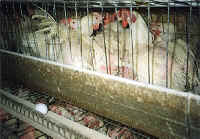 (Chicken - Egg Production - 02) This is another look at the hens in a battery cage. Notice the poor condition of their feathers. By constantly rubbing against their wire cages, egg laying hens suffer from severe feather loss. This is a human-caused condition! (Chicken - Egg Production - 02) This is another look at the hens in a battery cage. Notice the poor condition of their feathers. By constantly rubbing against their wire cages, egg laying hens suffer from severe feather loss. This is a human-caused condition! |
 (Chicken - Egg Production - 03) Practically all egg laying chickens in the U.S. live in crowded wire battery cages which are lined up in rows and stacked in tiers. Simply because humans have the power to treat chickens with such cruelty, doesn't make it right or just. Evil is evil, no matter how we try to excuse it. (Chicken - Egg Production - 03) Practically all egg laying chickens in the U.S. live in crowded wire battery cages which are lined up in rows and stacked in tiers. Simply because humans have the power to treat chickens with such cruelty, doesn't make it right or just. Evil is evil, no matter how we try to excuse it. |
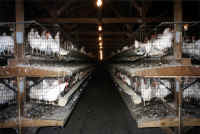 (Chicken - Egg Production - 04) Standing on slanted wire floors, battery caged laying hens commonly suffer from foot and leg maladies. To these egg farmers, the suffering of the chickens is of little or no importance - if it allows the eggs to automatically roll out of the cages, so that their labor costs are kept down. (Chicken - Egg Production - 04) Standing on slanted wire floors, battery caged laying hens commonly suffer from foot and leg maladies. To these egg farmers, the suffering of the chickens is of little or no importance - if it allows the eggs to automatically roll out of the cages, so that their labor costs are kept down. |
 (Chicken - Egg Production - 05) One of the hens in this battery house escaped her cage and is standing in the aisle between the tiers of cages. The problem is, she still cannot escape her endless suffering, because she is still locked inside the building. Such inhumane treatment of another living and feeling being is demonic. (Chicken - Egg Production - 05) One of the hens in this battery house escaped her cage and is standing in the aisle between the tiers of cages. The problem is, she still cannot escape her endless suffering, because she is still locked inside the building. Such inhumane treatment of another living and feeling being is demonic. |
 (Chicken - Egg Production - 06) This photo gives us a closer look at a single battery cage. Typically, four to five egg laying hens are packed into wire battery cage which has a floor the size of a folded newspaper. They cannot even stretch their wings. Stop this evil and cruel treatment of chickens. Stop eating eggs! (Chicken - Egg Production - 06) This photo gives us a closer look at a single battery cage. Typically, four to five egg laying hens are packed into wire battery cage which has a floor the size of a folded newspaper. They cannot even stretch their wings. Stop this evil and cruel treatment of chickens. Stop eating eggs! |
 (Chicken - Egg Production - 07) These battery cages are so small that the hens can't even stand up without their heads sticking out through the wire at the top of the cage. This is an example of how human beings pile one evil act upon another. It's time it stops! (Chicken - Egg Production - 07) These battery cages are so small that the hens can't even stand up without their heads sticking out through the wire at the top of the cage. This is an example of how human beings pile one evil act upon another. It's time it stops! |
 (Chicken - Egg Production - 08) Every year millions of egg laying hens die in their battery cages. This dead hen was removed from her cage and laid on top of it. (Chicken - Egg Production - 08) Every year millions of egg laying hens die in their battery cages. This dead hen was removed from her cage and laid on top of it. |
 (Chicken - Egg Production - 09) This photo was taken at an ISC factory farming operation where there are 800,000 laying hens confined in small cages. The sheer magnitude of this concentration camp staggers ones imagination. (Chicken - Egg Production - 09) This photo was taken at an ISC factory farming operation where there are 800,000 laying hens confined in small cages. The sheer magnitude of this concentration camp staggers ones imagination. |
 (Chicken - Egg Production - 10) Some hens manage to escape from their cages, only to fall into the manure pits below, where they meet a slow death without food or water. (Chicken - Egg Production - 10) Some hens manage to escape from their cages, only to fall into the manure pits below, where they meet a slow death without food or water. |
 (Chicken - Egg Production - 11) In the manure pits, Compassion Over Killing (COK) investigators found mass graves of dead hens, presumably discarded by workers. The chickens that are alive have to live in the stench and fumes of the rotting remains of their companions and their own feces. (Chicken - Egg Production - 11) In the manure pits, Compassion Over Killing (COK) investigators found mass graves of dead hens, presumably discarded by workers. The chickens that are alive have to live in the stench and fumes of the rotting remains of their companions and their own feces. |
 (Chicken - Egg Production - 12) COK investigators reported that the battery cage buildings at ISC were infested with billions of flies. Note how many have accumulated in the pail of bad eggs. Perhaps ISC hopes that the chickens will supplement their diet with these flies, but we can't help wondering what diseases may also be involved. (Chicken - Egg Production - 12) COK investigators reported that the battery cage buildings at ISC were infested with billions of flies. Note how many have accumulated in the pail of bad eggs. Perhaps ISC hopes that the chickens will supplement their diet with these flies, but we can't help wondering what diseases may also be involved. |
 (Chicken - Egg Production - 13) Many hens get their heads stuck beneath the feeding trough and die of dehydration. We believe this happens because the hens are trying to rescue their newly laid eggs which have rolled away. To us, this proves how emotionally distressing these "torture chambers" are to the chickens, who on top of all of their other suffering, lose their children over and over again day after day. (Chicken - Egg Production - 13) Many hens get their heads stuck beneath the feeding trough and die of dehydration. We believe this happens because the hens are trying to rescue their newly laid eggs which have rolled away. To us, this proves how emotionally distressing these "torture chambers" are to the chickens, who on top of all of their other suffering, lose their children over and over again day after day. |
 (Chicken - Egg Production - 14) This hen has her leg caught between the bars of two cages. She is still alive, but will soon die if not released. To the egg farmers, the life of a single chicken appears to be of no value. Photos like these prove to us the evilness of factory farming, and how ungodly these farmers really are. It's as we are told in Proverbs 12:10, "A righteous man has regard for the life of his animal, But even the compassion of the wicked is cruel." (Chicken - Egg Production - 14) This hen has her leg caught between the bars of two cages. She is still alive, but will soon die if not released. To the egg farmers, the life of a single chicken appears to be of no value. Photos like these prove to us the evilness of factory farming, and how ungodly these farmers really are. It's as we are told in Proverbs 12:10, "A righteous man has regard for the life of his animal, But even the compassion of the wicked is cruel." |
 (Chicken - Egg Production - 15) Hens who get caught underneath feeding troughs suffer from routine trampling from other birds until they finally die from dehydration. It's as though these battery cages were deliberately designed to cause the chickens as much pain and suffering as possible while providing the maximum profit. "For the love of money is a root of all sorts of evil, and some by longing for it have wandered away from the faith and pierced themselves with many griefs" (1 Timothy 6:10). (Chicken - Egg Production - 15) Hens who get caught underneath feeding troughs suffer from routine trampling from other birds until they finally die from dehydration. It's as though these battery cages were deliberately designed to cause the chickens as much pain and suffering as possible while providing the maximum profit. "For the love of money is a root of all sorts of evil, and some by longing for it have wandered away from the faith and pierced themselves with many griefs" (1 Timothy 6:10). |
 (Chicken - Egg Production - 16) This hen was still alive. She had woven her neck between the bars of her cage. COK investigators freed her neck and gave her water. From the condition of the hen it is obvious that no farm worker made any attempt to rescue her. (Chicken - Egg Production - 16) This hen was still alive. She had woven her neck between the bars of her cage. COK investigators freed her neck and gave her water. From the condition of the hen it is obvious that no farm worker made any attempt to rescue her. |
 (Chicken - Egg Production - 17) We believe that these cruel egg farmers have crammed 8 hens into this cage. Such crowding causes enormous psychological and physical strain upon these chickens. Every person who eats an egg contributes to this suffering. (Chicken - Egg Production - 17) We believe that these cruel egg farmers have crammed 8 hens into this cage. Such crowding causes enormous psychological and physical strain upon these chickens. Every person who eats an egg contributes to this suffering. |
 (Chicken - Egg Production - 18) On the average, each of the hens in these battery cages has only about 52 square inches of cage "floor" area. That's an area of 7-1/4 inches by 7-1/4 inches. They spend most of their lives there simply because some human beings have the power to force them to do so, and most other people don't seem to care. It's time we start caring! (Chicken - Egg Production - 18) On the average, each of the hens in these battery cages has only about 52 square inches of cage "floor" area. That's an area of 7-1/4 inches by 7-1/4 inches. They spend most of their lives there simply because some human beings have the power to force them to do so, and most other people don't seem to care. It's time we start caring! |
 (Chicken - Egg Production - 19) Every time we publish another of these photos in this photo journal, it increases our resolve to end the suffering that our fellow human beings inflict upon these innocent beings. Join us, and stop eating animals and their by-products; and tell others why you have stopped. (Chicken - Egg Production - 19) Every time we publish another of these photos in this photo journal, it increases our resolve to end the suffering that our fellow human beings inflict upon these innocent beings. Join us, and stop eating animals and their by-products; and tell others why you have stopped. |
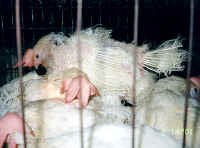 (Chicken - Egg Production - 20) These cages are so crowded that all the hens don't have enough space to sit or lie down at the same time. In order to find space to sit and lie down, this hen was forced to climb on top of the other hens. Note the horrible condition of the top hen's feathers, most of which have been lost. (Chicken - Egg Production - 20) These cages are so crowded that all the hens don't have enough space to sit or lie down at the same time. In order to find space to sit and lie down, this hen was forced to climb on top of the other hens. Note the horrible condition of the top hen's feathers, most of which have been lost. |
 (Chicken - Egg Production - 21) Overcrowded conditions lead to feather loss which is caused by the struggle for space and by constantly rubbing against the wire of the cages. To force chickens to live this way is evil and ungodly. (Chicken - Egg Production - 21) Overcrowded conditions lead to feather loss which is caused by the struggle for space and by constantly rubbing against the wire of the cages. To force chickens to live this way is evil and ungodly. |
 (Chicken - Egg Production - 22) This hen has suffered such severe feather loss that a large area of her skin is bare. This is cruel and inhumane treatment; but the law says that because it's standard practice in the industry, it doesn't break the law. That doesn't make it any less evil. (Chicken - Egg Production - 22) This hen has suffered such severe feather loss that a large area of her skin is bare. This is cruel and inhumane treatment; but the law says that because it's standard practice in the industry, it doesn't break the law. That doesn't make it any less evil. |
 (Chicken - Egg Production - 23) In addition to suffering severe feather loss, this hen has been splattered with feces from hens above her. (Chicken - Egg Production - 23) In addition to suffering severe feather loss, this hen has been splattered with feces from hens above her. |
 (Chicken - Egg Production - 24) Try to imagine the stress that these hens must be under. Imagine yourself being trapped in a passenger elevator with seven other people for two years, and you might come close to understanding what some people are doing to these chickens. Don't contribute to their pain and suffering. Stop eating eggs! (Chicken - Egg Production - 24) Try to imagine the stress that these hens must be under. Imagine yourself being trapped in a passenger elevator with seven other people for two years, and you might come close to understanding what some people are doing to these chickens. Don't contribute to their pain and suffering. Stop eating eggs! |
 (Chicken - Egg Production - 25) This photo shows more chickens suffering from severe feather loss because of the cruelty and indifference of human beings. It's time we begin to care and speak out! (Chicken - Egg Production - 25) This photo shows more chickens suffering from severe feather loss because of the cruelty and indifference of human beings. It's time we begin to care and speak out! |
 (Chicken - Egg Production - 26) More feather loss and more misery - the story of an egg laying battery hen's life. And, everyone who eats eggs contributes to their suffering. (Chicken - Egg Production - 26) More feather loss and more misery - the story of an egg laying battery hen's life. And, everyone who eats eggs contributes to their suffering. |
 (Chicken - Egg Production - 27) This hen has lost so many feathers that she is almost completely bald. Speak up! Its time to say no to this pain and suffering. Stop eating eggs, and any animals. (Chicken - Egg Production - 27) This hen has lost so many feathers that she is almost completely bald. Speak up! Its time to say no to this pain and suffering. Stop eating eggs, and any animals. |
 (Chicken - Egg Production - 28) This is a photo of a hen with an eye infection. Since vet care costs more than allowing hens to languish and die, these types of injuries are ignored by the egg industry. This is just another example of the pain and suffering that is in every egg. (Chicken - Egg Production - 28) This is a photo of a hen with an eye infection. Since vet care costs more than allowing hens to languish and die, these types of injuries are ignored by the egg industry. This is just another example of the pain and suffering that is in every egg. |
 (Chicken - Egg Production - 29) This is another hen with an eye problem. She has a growth over her eye which has remained untreated. This is one of the reasons that we believe that the animal agriculture industry is evil. (Chicken - Egg Production - 29) This is another hen with an eye problem. She has a growth over her eye which has remained untreated. This is one of the reasons that we believe that the animal agriculture industry is evil. |
 (Chicken - Egg Production - 30) This hen is suffering with a tumor or infection on the side of her head. (Chicken - Egg Production - 30) This hen is suffering with a tumor or infection on the side of her head. |
 (Chicken - Egg Production - 31) The hen in the foreground has an untreated infected cut on the back of her head, which was most likely caused by the sharp end of one of the wires in the cage. (Chicken - Egg Production - 31) The hen in the foreground has an untreated infected cut on the back of her head, which was most likely caused by the sharp end of one of the wires in the cage. |
 (Chicken - Egg Production - 32) Dead hens commonly go unnoticed in battery cages, forcing the living to eat and sleep on top of the corpses of their former cellmates. To us, this is just another example of how evil the farmed animal industry really is. (Chicken - Egg Production - 32) Dead hens commonly go unnoticed in battery cages, forcing the living to eat and sleep on top of the corpses of their former cellmates. To us, this is just another example of how evil the farmed animal industry really is. |
 (Chicken - Egg Production - 33) Compassion Over Killing investigators found this dead chicken lying on top of a cage of living hens. We find it difficult to understand why a farm worker, who had pulled this dead chicken out of a cage, would leave her on top to rot. Our only answer is that such people are totally devoid of any compassion. Surely, such a lack of compassion can be defined as evil. (Chicken - Egg Production - 33) Compassion Over Killing investigators found this dead chicken lying on top of a cage of living hens. We find it difficult to understand why a farm worker, who had pulled this dead chicken out of a cage, would leave her on top to rot. Our only answer is that such people are totally devoid of any compassion. Surely, such a lack of compassion can be defined as evil. |
 (Chicken - Egg Production - 34) Here is another dead and decomposing hen that was found lying on top of this battery cage. Represented here is just a small part of the misery that is in every egg that is sold or eaten. (Chicken - Egg Production - 34) Here is another dead and decomposing hen that was found lying on top of this battery cage. Represented here is just a small part of the misery that is in every egg that is sold or eaten. |
 (Chicken - Egg Production - 35) Apparently, this hen died of dehydration after she became stuck between the wire bars of her cage. All we can presume is that no one cared. The time and effort needed to release this hen must have been considered more costly than the life and value of the chicken. (Chicken - Egg Production - 35) Apparently, this hen died of dehydration after she became stuck between the wire bars of her cage. All we can presume is that no one cared. The time and effort needed to release this hen must have been considered more costly than the life and value of the chicken. |
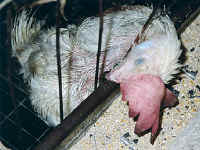 (Chicken - Egg Production - 36) This dead hen is lying with her head in the food trough. It is hard for us to understand how this could have gone unnoticed by the farm workers. Obviously they didn't care. Rightly so does the Bible teach us that "the compassion of the wicked is cruel." (Chicken - Egg Production - 36) This dead hen is lying with her head in the food trough. It is hard for us to understand how this could have gone unnoticed by the farm workers. Obviously they didn't care. Rightly so does the Bible teach us that "the compassion of the wicked is cruel." |
 (Chicken - Egg Production - 37) Evidently, this hen accidentally hanged herself when she got her head twisted around the wires at the top of her battery cage. Eggs don't come to the table without death. Some die sooner and some suffer on to die later. (Chicken - Egg Production - 37) Evidently, this hen accidentally hanged herself when she got her head twisted around the wires at the top of her battery cage. Eggs don't come to the table without death. Some die sooner and some suffer on to die later. |
 (Chicken - Egg Production - 38) Apparently, this hen was standing on top of another hen. When the lower hen moved, the one above was left hanging by her neck. These cages are not designed to protect the hens. They are designed as inexpensively as possible only to keep the hens confined. (Chicken - Egg Production - 38) Apparently, this hen was standing on top of another hen. When the lower hen moved, the one above was left hanging by her neck. These cages are not designed to protect the hens. They are designed as inexpensively as possible only to keep the hens confined. |
 (Chicken - Egg Production - 39) This badly decomposed hen was found in the bottom of a battery cage with living chickens still in it. Concern for the life and well-being of farmed animals appears to be nonexistent. Apparently, all these people value is their financial statement's bottom line. (Chicken - Egg Production - 39) This badly decomposed hen was found in the bottom of a battery cage with living chickens still in it. Concern for the life and well-being of farmed animals appears to be nonexistent. Apparently, all these people value is their financial statement's bottom line. |
 (Chicken - Egg Production - 40) This is a photo of a caged egg-laying hen with a painful eye infection that has gone untreated at a Buckeye factory farm in Ohio. (Chicken - Egg Production - 40) This is a photo of a caged egg-laying hen with a painful eye infection that has gone untreated at a Buckeye factory farm in Ohio. |
 (Chicken - Egg Production - 41) This is what happens when a painful eye infection goes untreated. "It is outrageous that the operators neglect hens who are suffering so horribly from acute and chronic eye infections and injuries to the eyes -- one of the most painful of all areas of the body when afflicted. With eye injuries such as these, the failure to provide appropriate treatment and veterinary care is the height of irresponsibility." --Elliot M. Katz, DVM. (Chicken - Egg Production - 41) This is what happens when a painful eye infection goes untreated. "It is outrageous that the operators neglect hens who are suffering so horribly from acute and chronic eye infections and injuries to the eyes -- one of the most painful of all areas of the body when afflicted. With eye injuries such as these, the failure to provide appropriate treatment and veterinary care is the height of irresponsibility." --Elliot M. Katz, DVM. |
 (Chicken - Egg Production - 42) This laying hen, with a painful untreated eye infection, was removed from the cage. As long as people want cheap eggs to eat, the cruelty will continue to exist. The answer? Stop eating eggs! (Chicken - Egg Production - 42) This laying hen, with a painful untreated eye infection, was removed from the cage. As long as people want cheap eggs to eat, the cruelty will continue to exist. The answer? Stop eating eggs! |
 (Chicken - Egg Production - 43) This is another battery hen, with an untreated painful eye infection, at a Buckeye factory farm in Ohio. "It is the love of money that leads to such evil" (1 Timothy 6:10), for it is less expensive to allow this living soul to suffer until she dies than it is to treat her infection, or even to euthanize her. And, every egg that is purchased contributes to this evil. (Chicken - Egg Production - 43) This is another battery hen, with an untreated painful eye infection, at a Buckeye factory farm in Ohio. "It is the love of money that leads to such evil" (1 Timothy 6:10), for it is less expensive to allow this living soul to suffer until she dies than it is to treat her infection, or even to euthanize her. And, every egg that is purchased contributes to this evil. |
 (Chicken - Egg Production - 44) From what we have learned, eye infection seems to be quite common among battery hens. We believe that the major contributing factor is the ammonia gas coming from the manure coupled with the crowded unsanitary conditions. (Chicken - Egg Production - 44) From what we have learned, eye infection seems to be quite common among battery hens. We believe that the major contributing factor is the ammonia gas coming from the manure coupled with the crowded unsanitary conditions. |
 (Chicken - Egg Production - 45) This hen is suffering from a serious sinus infection. Without proper veterinary care, this condition will only get worse, and the chicken will continue to suffer until she dies. To allow this to happen is evil, and it shows us how depraved some humans can be. (Chicken - Egg Production - 45) This hen is suffering from a serious sinus infection. Without proper veterinary care, this condition will only get worse, and the chicken will continue to suffer until she dies. To allow this to happen is evil, and it shows us how depraved some humans can be. |
 (Chicken - Egg Production - 46) This hen is suffering from an infection that has caused severe swelling on the side of her face. She feels pain just as much as we do. As long as humans demand cheap eggs, this suffering and depraved indifference to life will continue. (Chicken - Egg Production - 46) This hen is suffering from an infection that has caused severe swelling on the side of her face. She feels pain just as much as we do. As long as humans demand cheap eggs, this suffering and depraved indifference to life will continue. |
 (Chicken - Egg Production - 47) This is another hen with a severely swollen head which was caused by an untreated infection. Stop the cruelty! Stop eating eggs! (Chicken - Egg Production - 47) This is another hen with a severely swollen head which was caused by an untreated infection. Stop the cruelty! Stop eating eggs! |
 (Chicken - Egg Production - 48) This hen's wing is caught between the wires of a battery cage. She is unable to get to food or water or to lie down. She is painfully suspended in an upright position. Imagine having your hand and wrist tied to a shower curtain rod so that you can't sit down or get to drinking water for more than a whole day, and you might have some idea what this hen is suffering. (Chicken - Egg Production - 48) This hen's wing is caught between the wires of a battery cage. She is unable to get to food or water or to lie down. She is painfully suspended in an upright position. Imagine having your hand and wrist tied to a shower curtain rod so that you can't sit down or get to drinking water for more than a whole day, and you might have some idea what this hen is suffering. |
 (Chicken - Egg Production - 49) This is another hen who has been caught in the wires of a battery cage. In this condition, she is unable to get to food or water. This problem is caused by humans who consider cheap construction costs more important than the welfare of the chickens. The Bible tells us that this is evil (1 Timothy 6:10); since, to such people, the love of money far outweighs concern for the lives of chickens. (Chicken - Egg Production - 49) This is another hen who has been caught in the wires of a battery cage. In this condition, she is unable to get to food or water. This problem is caused by humans who consider cheap construction costs more important than the welfare of the chickens. The Bible tells us that this is evil (1 Timothy 6:10); since, to such people, the love of money far outweighs concern for the lives of chickens. |
 (Chicken - Egg Production - 50) This hen's foot is swollen to several times its natural size. One of the evils of this egg industry is that they don't spend any money on veterinary care for sick and injured hens. Because money is their god, those in this industry consider it less expensive to let the hens suffer and die than to treat their problems. Don't be part of this ungodliness! Don't buy or eat eggs! (Chicken - Egg Production - 50) This hen's foot is swollen to several times its natural size. One of the evils of this egg industry is that they don't spend any money on veterinary care for sick and injured hens. Because money is their god, those in this industry consider it less expensive to let the hens suffer and die than to treat their problems. Don't be part of this ungodliness! Don't buy or eat eggs! |
 (Chicken - Egg Production - 51) Because the battery hens never get a chance to scratch the ground, as God intended them to do, their toe nails are not ground down. As a result they grow too large (see photo). This condition makes it both difficult and painful to even stand properly. (Chicken - Egg Production - 51) Because the battery hens never get a chance to scratch the ground, as God intended them to do, their toe nails are not ground down. As a result they grow too large (see photo). This condition makes it both difficult and painful to even stand properly. |
 (Chicken - Egg Production - 52) This hen died with her head stuck in the egg trough. (Chicken - Egg Production - 52) This hen died with her head stuck in the egg trough. |
 (Chicken - Egg Production - 53) Laying hens are forced to stand every moment of every day on wire bottom cages which hurt their feet. When a cage mate dies, the live chickens will stand on top of the dead one to relieve the pain. From the condition of dead chicken, she has obviously been left in the cage for a long time. (Chicken - Egg Production - 53) Laying hens are forced to stand every moment of every day on wire bottom cages which hurt their feet. When a cage mate dies, the live chickens will stand on top of the dead one to relieve the pain. From the condition of dead chicken, she has obviously been left in the cage for a long time. |
 (Chicken - Egg Production - 54) This is the body of another dead chicken that has been left to decompose in the bottom of a battery cage. This is proof positive that eating eggs DOES contribute to chicken suffering and death. (Chicken - Egg Production - 54) This is the body of another dead chicken that has been left to decompose in the bottom of a battery cage. This is proof positive that eating eggs DOES contribute to chicken suffering and death. |
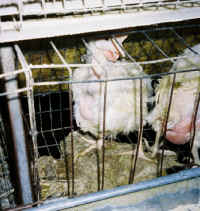 (Chicken - Egg Production - 55) This is another photo of hens standing on the decomposing body of a dead cage mate. There is no compassion in the factory farming industry! (Chicken - Egg Production - 55) This is another photo of hens standing on the decomposing body of a dead cage mate. There is no compassion in the factory farming industry! |
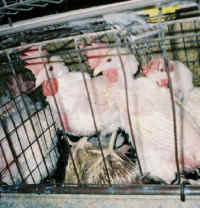 (Chicken - Egg Production - 56) ...and another photos of a hen standing on the decomposing body of another her... After seeing the reality of the cruelty involved in factory farming operations, people frequently write to us and say that they are ashamed to be a member of the human race. When we read statements like these, we think about how much worse God must feel about the human race, since He lovingly created all the animals and charged humans with compassionately caring for them. (Chicken - Egg Production - 56) ...and another photos of a hen standing on the decomposing body of another her... After seeing the reality of the cruelty involved in factory farming operations, people frequently write to us and say that they are ashamed to be a member of the human race. When we read statements like these, we think about how much worse God must feel about the human race, since He lovingly created all the animals and charged humans with compassionately caring for them. |
Forced Molting
 (Chicken - Forced Molting - 01) As laying hens age, they begin to lay fewer eggs. So, in order to increase their profits, the egg industry starves the hens for up to two weeks, causing the hens to molt. The forced molting puts the hens in a survival mode, so that when they are fed again, they begin to lay more eggs. Financial gain does not justify such evil practices. (Chicken - Forced Molting - 01) As laying hens age, they begin to lay fewer eggs. So, in order to increase their profits, the egg industry starves the hens for up to two weeks, causing the hens to molt. The forced molting puts the hens in a survival mode, so that when they are fed again, they begin to lay more eggs. Financial gain does not justify such evil practices. |
 (Chicken - Forced Molting - 02) This hen was rescued after living for months in a dark shed with thousands of other hens, all stuffed into cages with three-six other hens. Being starved of food or water, she was forced molted several times before being rescued. Here she enjoys the first moments of peace she may have ever experienced. (Chicken - Forced Molting - 02) This hen was rescued after living for months in a dark shed with thousands of other hens, all stuffed into cages with three-six other hens. Being starved of food or water, she was forced molted several times before being rescued. Here she enjoys the first moments of peace she may have ever experienced. |
 (Chicken - Forced Molting - 03) Hens might be force-moulted one more time, or even twice, in order to get as many eggs from your tired body as possible. And then, when—like the dairy cow—you can’t produce enough of your reproductive secretions, you become cheap meat—dog food, soup, or baby food. You will be less than two years old, about a tenth of your potential lifespan. (Chicken - Forced Molting - 03) Hens might be force-moulted one more time, or even twice, in order to get as many eggs from your tired body as possible. And then, when—like the dairy cow—you can’t produce enough of your reproductive secretions, you become cheap meat—dog food, soup, or baby food. You will be less than two years old, about a tenth of your potential lifespan. |
Meat Production
 (Chicken - Broiler - 01) The name "broiler" is a term that the farmed chicken industry uses for chickens who are raised for meat. In these concentration camps, these chickens are crowded together by the thousands in "grower houses" where each chicken is given approximately half a square foot of space. (Chicken - Broiler - 01) The name "broiler" is a term that the farmed chicken industry uses for chickens who are raised for meat. In these concentration camps, these chickens are crowded together by the thousands in "grower houses" where each chicken is given approximately half a square foot of space. | |
 (Chicken - Broiler - 02) This is another view of chickens who are raised for meat being crowded by the thousands in "grower houses." Approximately nine billion chickens like these are slaughtered every year in the U.S. They are being deprived of their God-given liberty for their entire lives. This is evil! The Bible teaches us that we are to "rule" over the animals in the same way we expect our elected government officials to "rule" over us. (Chicken - Broiler - 02) This is another view of chickens who are raised for meat being crowded by the thousands in "grower houses." Approximately nine billion chickens like these are slaughtered every year in the U.S. They are being deprived of their God-given liberty for their entire lives. This is evil! The Bible teaches us that we are to "rule" over the animals in the same way we expect our elected government officials to "rule" over us. | |
 (Chicken - Broiler - 03) This is another photo of the horribly crowded conditions that exist on factory farms. These chickens never get a chance to go outside and feel the grass under their feet. The only time they leave is when they are being transported to their death. (Chicken - Broiler - 03) This is another photo of the horribly crowded conditions that exist on factory farms. These chickens never get a chance to go outside and feel the grass under their feet. The only time they leave is when they are being transported to their death. | |
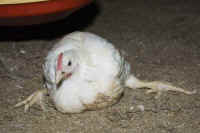 (Chicken - Broiler - 04) Selective breeding and genetic manipulation create legs and organs that are unable to support the unnatural growth. Perosis, twisted leg, and heart attacks are common. To produce the huge "chicken breast" that brings profit, this bird cannot even stand up. This bird is about seven weeks old and will be sent to slaughter in a matter of days. (Chicken - Broiler - 04) Selective breeding and genetic manipulation create legs and organs that are unable to support the unnatural growth. Perosis, twisted leg, and heart attacks are common. To produce the huge "chicken breast" that brings profit, this bird cannot even stand up. This bird is about seven weeks old and will be sent to slaughter in a matter of days. |
Transport
 (Chicken - Transport - 01) Chickens aren't offered any compassion. We have seen videos taken in their crowded "houses" showing chickens being grabbed by the feet by "handlers" and held upside down, several in each hand, and thrust into shipping crates like these chickens who have been loaded onto a truck for transport to a slaughterhouse. (Chicken - Transport - 01) Chickens aren't offered any compassion. We have seen videos taken in their crowded "houses" showing chickens being grabbed by the feet by "handlers" and held upside down, several in each hand, and thrust into shipping crates like these chickens who have been loaded onto a truck for transport to a slaughterhouse. |
 (Chicken - Transport - 02) This is a closer look at the chickens in their crowded shipping crates as they are being transported to the slaughterhouse. Every time a person eats a part of a chicken's body, he or she contributes to the suffering of these birds. (Chicken - Transport - 02) This is a closer look at the chickens in their crowded shipping crates as they are being transported to the slaughterhouse. Every time a person eats a part of a chicken's body, he or she contributes to the suffering of these birds. |
 (Chicken - Transport - 03) At the slaughterhouse, the crates are unloaded by a small crane. We have seen concrete blocks and gypsum wallboard being unloaded like this on a construction site. These chickens aren't inanimate objects; they have emotions and feelings just as we have. Only humans are capable of such insensitivity. (Chicken - Transport - 03) At the slaughterhouse, the crates are unloaded by a small crane. We have seen concrete blocks and gypsum wallboard being unloaded like this on a construction site. These chickens aren't inanimate objects; they have emotions and feelings just as we have. Only humans are capable of such insensitivity. |
Slaughter
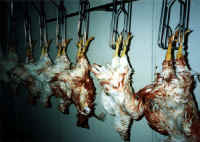 (Chicken - Slaughter - 01) Every hour at the slaughterhouse, thousands of chickens are hung upside down in shackles on a conveyer and killed. We can only imagine the terror that they feel. (Chicken - Slaughter - 01) Every hour at the slaughterhouse, thousands of chickens are hung upside down in shackles on a conveyer and killed. We can only imagine the terror that they feel. |
 (Chicken - Slaughter - 02) This is another photo of chickens in a slaughterhouse. When we became aware of the pain and suffering that our fellow human beings inflict upon other living beings, we adopted a vegan diet as a protest against this holocaust and no longer eat any animals or their by-products. (Chicken - Slaughter - 02) This is another photo of chickens in a slaughterhouse. When we became aware of the pain and suffering that our fellow human beings inflict upon other living beings, we adopted a vegan diet as a protest against this holocaust and no longer eat any animals or their by-products. |
Suscribirse a:
Entradas (Atom)



